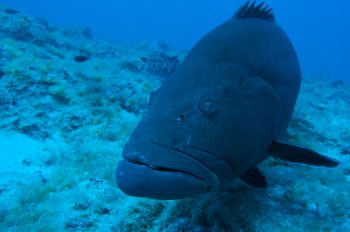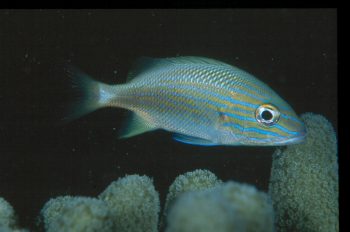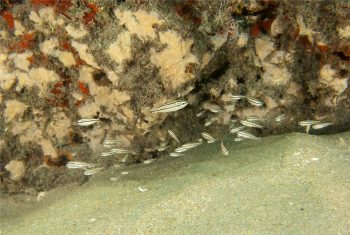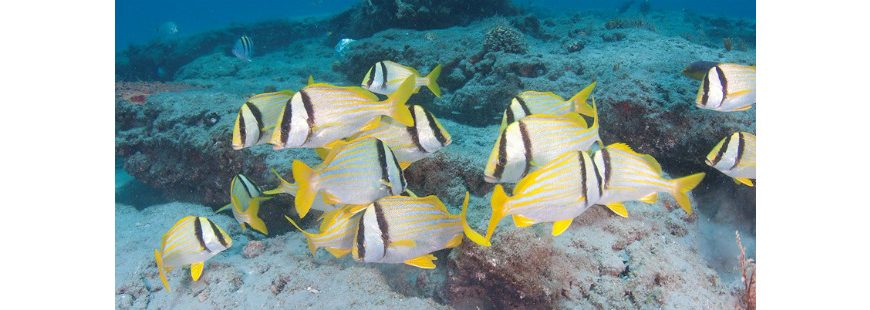Photo: Porkfish are some of the larger and more beautiful of the species in the generally colorful grunt clan. Photo credit: David Snyder
Like many kids who grew up in South Florida, some of my earliest memories in and on the water are filled with grunts. When we were very young children, my sister and I and other kids of cohort age spent the summers soaking shrimp off docks in the Lake Worth Lagoon, just inside the Palm Beach (North Lake Worth) and Boynton (South Lake Worth) inlets. We caught a huge variety of species off those docks, but I remember the grunts most vividly from early childhood, mostly because we caught a lot of those vividly colored fish with the bright red mouths for which they earned their family name. Here’s a fact that ought to wow your kids’ science teachers: The scientific name for the grunt family is Haemulidae, which is derived from the Greek, haimaleos, which means bloody, and the Latin, haemulon, or “bloody gum.”
Thanks to fishing and snorkeling, we picked up on how grunts play hugely important, if under-appreciated, roles in coastal fisheries. Though we were so young I don’t remember, I’d bet that the first saltwater species we caught included some type of grunt, perhaps a white grunt, tomtate or porkfish. My mother is fond of pointing out that my conservation ethos has evolved considerably since I was four or five, when I insisted upon keeping every grunt of edible size and individuals of other species north on the desirability scale of the hardhead catfish. But I don’t remember her complaining about the golden filets piled next to a heaping helping of cheese grits and steaming collards, or shouldering any of the “blame” for encouraging my predatorial instincts by serving food that good.
Life History Lessons

This black grouper was photographed on Riley’s Hump, in the Dry Tortugas National Park. Riley’s Hump is a well-documented, multi-species spawning aggregation site, where many varieties of snappers, groupers and jacks reproduce. Grunts are one of the most important forage sources for these breeder groupers. Photo credit: Don DeMaria
Fishing and snorkeling also led to a fundamental understanding about the life histories and roles that grunts play in ecosystems, ecosystems that our generation now must work hard to repair.
In the late 1970s and early 80s, the Lake Worth Lagoon was terribly polluted and essential fish habitats (EFH) such as sea grasses and oysters were woefully diminished. From the stories of my father and grandfathers, I was keenly aware from a very early age that we weren’t growing up fishing in paradise. Many changes—none for the better—had occurred in a body of water that white settlers had altered from a pristine freshwater lagoon fed by Everglades seepage, to a saltwater estuary, to a muddy, putrid ditch contained by seawalls. Dredge-and-fill projects for roads and developments, sewage discharges and runoff had left all but the well-flushed parts of the lagoon near the inlets an ecological wreck. On the beach side, a growing number of massive dredge-and-fill projects, spun as “beach nourishment,” buried nearshore reefs and turned the bright, clear water cloudy.
Still, the cerulean Gulf Stream current, which comes right to shore during the summer months off Palm Beach County, carried innumerable planktonic plants and animals—including grunts—onto the remaining nearshore reefs along beaches and into remnant and manmade habitats in the lagoon. Remarkably powerful incoming tides and onshore winds would usher bright blue water into an urban waterway and onto the nearshore reefs where we fished and snorkeled and learned.
I vividly remember an early lesson in foodweb ecology, the first time I realized that grunts feed other species than humans. My sister and I were snorkeling the nearshore hardbottom reefs at Ocean Reef Park with my grandmother late one spring, I think a few days before I finished the first grade. Shimmering clouds of what I now know to call “newly settled” grunts surrounded us. Tiny, translucent fish with thin black bars danced in the little waves washing over reef so shallow we could stand up and yell to grandma when we saw something cool, like the juvenile barracudas that followed us down the reef, “grinning,” before darting through the shimmering schools and leaving a shower of tiny scales. Meanwhile, wily snook sat in ambush positions around worm reef mounds and from under ledges, while racing schools of jacks marauded through the tiny reef fish.
Diving Deeper

Believe it or not, the Florida state record white grunts weighed 15 pounds, 8 ounces. The species is a staple for headboats in the Florida Keys and off the southwest coast of Florida. Photo credit: David Snyder
During many subsequent immersions at great snorkeling places such as the Lake Worth Pier, Phipps Park, and the inlet jetties, my sister and I grew braver and ventured deeper. We found bigger fish, including larger, mature grunts, as we ventured out into eight, ten and 15 feet of water.
Though juvenile grunts are found on deeper reefs and adult grunts occur in the shallows, generally speaking the fish aggregate according to size and trend larger the deeper you dive or fish along the continental shelf. The general increase in grunt size across depths is an aspect of their ontogenetic migrations, and, of course, the same if true of many other reef-associated species such as most species of snappers. The journeys these fishes make as they mature can take them from settling habitats such as seagrass and nearshore hardbottom out to relatively deep reefs on the continental shelf, once they grow big enough to compete and fend for themselves in areas frequented by large predators.
This migration is central to their life histories, and allows them to play an incredibly important role in the coastal foodweb. They carry the energy that has allowed them to grow, and the energy stored inside them, out to deeper, less fertile habitats, where they encounter different predators. Grunts, no matter what size or at which depth, are “bait” for something. Without the strong supporting role that grunts play in the foodweb—from estuaries to nearshore hardbottom to offshore reefs—larger, more popular species such as groupers and amberjacks would find themselves lacking a dependable forage source.
Summer School

These tiny grunts, probably tomtates, settled on a special type of Essential Fish Habitat known as “nearshore hardbottom.” These fish are swimming in only a few feet of water. Nearshore hardbottom provides cover from predators during a most vulnerable stage in their development. Photo credit: David Snyder
I’m grateful for fishing mentors that taught us more than we realized by teaching us how to fish and dive. Thanks to Harold Goffe, an old colorful character and commercial fishermen who kept his boat on one of three docks where we fished in the summers, we learned early on why the smaller grunts were in shallower water, hiding among pilings and rubble in waters too skinny for large-bodied predators to hunt in easily. Mr. Goffe taught us to use view grunts as exceptionally good baits, and taught us where and why larger predators positioned themselves along the manmade structure.
In a way, the docks we fished represented a microcosm of the reefs that run basically north/south along the narrow continental shelf off Southeast Florida. The docks run about 50 yards out into the lagoon, close to deep navigational channel. A series of ten-foot east/west “finger docks” divided boat slips separates them. The finger docks run out from a seawall that stops about three feet of water at high tide to about six feet. Those finger docks, along with rock rubble, create shallow reef habitat.
The main docks run west from the same seawall out to about 15 feet at high tide, give or take, depending on the moon phase and any surge. Finger docks also run north/south at intervals along either side of them. Each north/south structure is another high-relief reef at a different depth. Armed with effective bait and tackle, we learned that we could catch different sizes of different species of reef fish, plus lookdown, snook and tarpon, depending upon depth, tide and other factors, such as the presence of baitfish.
Mr. Goffe taught us to catch one- to three-inch grunts using handlines and tiny gold hooks that we tipped with small cubes of shrimp. We’d put a few baby grunts in a bucket, then pin them on a small livebait hook fished on “knocker rig.”
The knocker rig is so simple at first we hardly believed Mr. Goffe when he explained that it would work far better than a sinker fixed above the hook, which likes to tangle as it flutters downward above the weight. The knocker rig consists of an egg sinker sliding freely along the line above the hook. When the sinker hits the bottom, you pay out just enough line for the wiggling grunt (or any other baitfish) to put a little distance between the sinker and itself. Then you hold the line under your finger, so the bait struggles fruitlessly against the weight. The big “dock snappers,” wizened “gray” or more commonly “mangrove” snappers couldn’t resist a struggling grunt, not even the wily fish under the cleaning table, the ultimate fish aggregating device (FAD). We also caught mutton snappers and red groupers in the deeper water toward the end of the dock. And once our skills and tackle evolved enough to angle for snook and tarpon, we fed them grunts as well.
Reef Fertilizers
Grunts are “mudders” that feed on sand- and seagrass-dwelling invertebrates near reefs. If you look at the shape of the mouth, it’s a “skimmer” designed for scoping up small animals out of the bottom. When they’re done feeding, grunt schools return to the reef—often to the same coral head or heads—to rest and digest. On a morning dive in Grand Cayman last spring, I witnessed a phenomenon that I’d read about in scientific literature but never observed. A light bulb went off as I watched a school of grunts spray feces over a coral head, supplying the animals that build the reef’s foundation with energy. Grunts can contribute substantially to coral reef growth by providing the zooxanthellae with phosphorous and nitrogen through their excrement. Zooxanthellae are the symbiotic algae that live in coral tissues, and turn these nutrients into sugars and amino acids that corals turn into proteins, fats and carbohydrates. Witnessing that event reminded me again that fish are not just products of ecosystems; they are part of a community of organisms that all play a role or roles in maintaining the health our coastal environments.
Management Status
There doesn’t seem to be any evidence of unsustainable fishing on grunts, though for the most part they don’t get much scientific attention, and they’ve been fished hard for a long time. “Grits and grunts” served as staple throughout Florida’s pioneer days, and was popularized in Key West during the early 20th century. I’ve heard it said that grits and grunts provided most of the calories for the workers that built the Overseas Highway down through the Florida Keys.
Given their culinary history, popularity across almost all ethnic pallets, and increasing recreational fishing participation, we probably should start thinking harder about grunts.
There are at least twelve species of grunts (Haemulidae) in South Atlantic, Gulf of Mexico and U.S. Caribbean waters. The white grunt is arguably the most sought after by recreational anglers, especially along the Gulf Coast in the Tampa Bay area, where they are the staple of half-day headboat trips. Other members include the French, blue striped and cottonwick grunts, plus members of this important fish family that go by other names. Porkfish, black and white margates, as well as pigfish, are all Haemulids that support inshore and offshore commercial and recreational fisheries.
Fortunately, the South Atlantic Fishery Management Council sets annual catch limits (ACL) on four species of grunts, and ACLs are great tools that guard against overfishing due to continuous exploitation or shifts/increases in fishing pressure.
Grunts don’t enjoy such protections in the federal waters of the Gulf of Mexico, and in state waters, grunts are “unregulated species.” It appears that you can keep up to 100 pounds of unregulated species, which we might find excessive if our management system was set up to take into account the roles that grunts play in ecosystems.
By fishing grunts hard, are we reducing forage for other predators, and hindering the growth and reproduction of species such as amberjacks (AJs) and groupers? If we left more grunts in the water would we have more numerous and more fertile AJs and groupers, and longer seasons and/or more generous bag limit on those controversial species? If we left more grunts in the water, would coral reefs stay healthier, grow more quickly and stand a better chance against pollution, sedimentation and the stressors associated with climate change? How many more fish would healthier reefs produce and allow us to harvest?
These are the types of questions that scientists ponder while developing models that provide us with more information about how management decisions impact ecosystem productivity. I’d argue that the roles that grunts play across diverse habitats make the case for an ecosystem approach to their management, and to fisheries management in general. Hopefully, there’s a dock or reef near you that’s loaded with grunts and the lessons your kids can also begin to learn from them.


